 Editor’s note: As part of our blog event for The Summit at Sundance, we have invited participants in The Chief Executive Program to frame each of our problems to solve. Here, John Wetenhall poses a series of questions for thinking about the problem: Engage users/customers/stakeholders as true collaborators in shaping an institution’s agenda.
Editor’s note: As part of our blog event for The Summit at Sundance, we have invited participants in The Chief Executive Program to frame each of our problems to solve. Here, John Wetenhall poses a series of questions for thinking about the problem: Engage users/customers/stakeholders as true collaborators in shaping an institution’s agenda.
Beyond any fiscal challenges that cultural organizations may face, the core of what we do involves a meaningful, resonant and personal relationship with every human being who engages with our form of art. We enrich lives, strengthen communities and make the world a better place – on a person by person basis. This personal relationship has energy, intellect and emotion. It brings people together and can build bridges between cultures. It broadens our world. It carries the past to our present and helps to shape the future. It refines our values and so brings extraordinary value to all.
The challenge of audience engagement is not a problem, then, but an opportunity.
Culture in a Changing World
“The last thing we want is to hold a growing segment of a dying market…”
We understand demographic trends and appreciate the diversity of our potential audiences. We also know that technology, the internet and the accelerated speed of everyday life have changed people’s expectations. People are at once local residents and citizens of a global world. Yet even as individuals may feel their lives complicate while societies fragment, at our best, our cultural offerings can touch people’s souls and connect us all through our core humanity.
Are our core audiences aging? Are baby boomers less likely to participate in cultural offerings than the WWII generation? Are younger people coming to our venues in sufficient numbers to replace them?
Do growing diverse populations bring different expectations? What are they? What must we do to meet them?
Do people raised in the digital age have fundamentally different expectations than those whose education came primarily from books? Must we adapt for them? If so, how?
Presenting To Audiences
We possess extraordinary content about our art forms and exhibitions. What our curators, artistic directors, performers and educators know far exceeds the confines of a 100-word label or a page in the playbook. We possess enthralling stories that can ignite the curiosity of all kinds of people from gloriously different backgrounds. But how do we tell them? Who do we reach?
Are our internal structures and professional priorities aligned with the expectations of our audiences? Do “insider” dialogues with scholars, peers, critics or “the field” distance us from the general public that comes to our facilities? Do “insider” priorities leave visitors feeling inadequate, ill-informed or dumb? If so, what actions must we take?
By what means do we communicate what we know to our audiences? Are the old ways good enough? Or does a digital age require new delivery systems for engagement?
Must we change what we show or how we show it? Or neither? Or both?
Engaging With Audiences
The digital age has empowered individuals and created unprecedented expectations for active participation, including “self-curation” of experience. We understand that the privileged place of cultural institutions in the civic fabric is becoming ever-more blurred – especially in the public eye – as education and entertainment options proliferate. What is the role of individuals and their communities in shaping the substance of what we offer?
To what extent has the role of audience members changed? Do people wish to expand their roles from witness to participant? If so, how must we change their cultural experience?
How do cultural organizations listen? Is this really about focus groups and surveys, or is the dialogue more engaged, profound and simultaneous? How ready are the creators of our content willing to adapt? How do we establish a vibrant feedback loop?
Is there a necessary sequence between what we offer and what audiences/visitors wish to “curate” themselves? Is “self-expression” enough, or must experiencing our cultural offerings transform such expression? How do we mediate the experience? Must we?
Who speaks for the community? Politicians? Donors? Corporate leaders? Citizen groups? Board members? Survey Monkey? If we embrace community involvement as a driver of culture, do we expose our content to manipulation by special interests or the whimsies of fads and fashion? Do we self-censor?
How do we embrace both the aspirations of our communities and the integrity of the individual artist?
Will engaging audiences and communities in these ways give them a greater stake in our organizations, or do we need to think beyond programmatic concerns?
Strategies for Success
Decisions must be made.
If we wish to transform the audience experience, do we do so
Incrementally, via many small actions?
OR
Systemically, through game-changing organizational or field-wide transformations?
Can groups of us work together to seek new ways to engage audiences? Can we speed up innovation by sharing a common challenge to test new approaches simultaneously? How do we share winning strategies going forward?
What would you do? What works? Give examples and identify winning strategies for success.
More thoughts from the field
“![]() Many of our mission statements are mostly or entirely focused on the art that is the medium of our work. Such artcentricity, without consideration of art’s role in people’s lives, gets in the way of connecting with our communities and hinders sustainability.
Many of our mission statements are mostly or entirely focused on the art that is the medium of our work. Such artcentricity, without consideration of art’s role in people’s lives, gets in the way of connecting with our communities and hinders sustainability.
Unfortunately, some think that “art as service” demands a radical dismantling of the arts enterprise. Any work that proceeds from a self-understanding of responsibility in the community, anything to the right of artcentric, is good (note Yo-Yo Ma’s recent Kennedy Center lecture “Art for Life’s Sake”).
 In this middle ground the art grows out of or is a response to an existing relationship. This does not mean that we simply “give them what they want.” Giving people what they need rather than what they want can be a form of deep respect. But beware, if we are simply giving them what WE want to give, that is profound disrespect, and we cannot know what they need if we do not have relationships with them, if we do not know them.
In this middle ground the art grows out of or is a response to an existing relationship. This does not mean that we simply “give them what they want.” Giving people what they need rather than what they want can be a form of deep respect. But beware, if we are simply giving them what WE want to give, that is profound disrespect, and we cannot know what they need if we do not have relationships with them, if we do not know them.
Properly conceived, a mission serves as a life raft in the sea of troubles and the “shiny object ” temptations of artcentric goals. It should be informed by the realities of the market in which the organization exists and not simply the desires of the founders, artistic director, or the board. There are a lot of “generic” arts organizations–the symphony, theatre, dance company, or museum–that could be in any city in the country (or world). One reason they struggle is their lack of connection to a place. A community-focused mission is one way for an arts organization to differentiate itself from the crowd and, perhaps, make it stand out artistically and be more sustainable.”
— Doug Borwick (Engaging Matters)
How would you solve this problem? Add your ideas below!

“The last thing we want is to hold a growing segment of a dying market…” Too true. Interesting to see the relationships between differing market segments though!